Do I Need A Camera For Microsoldering
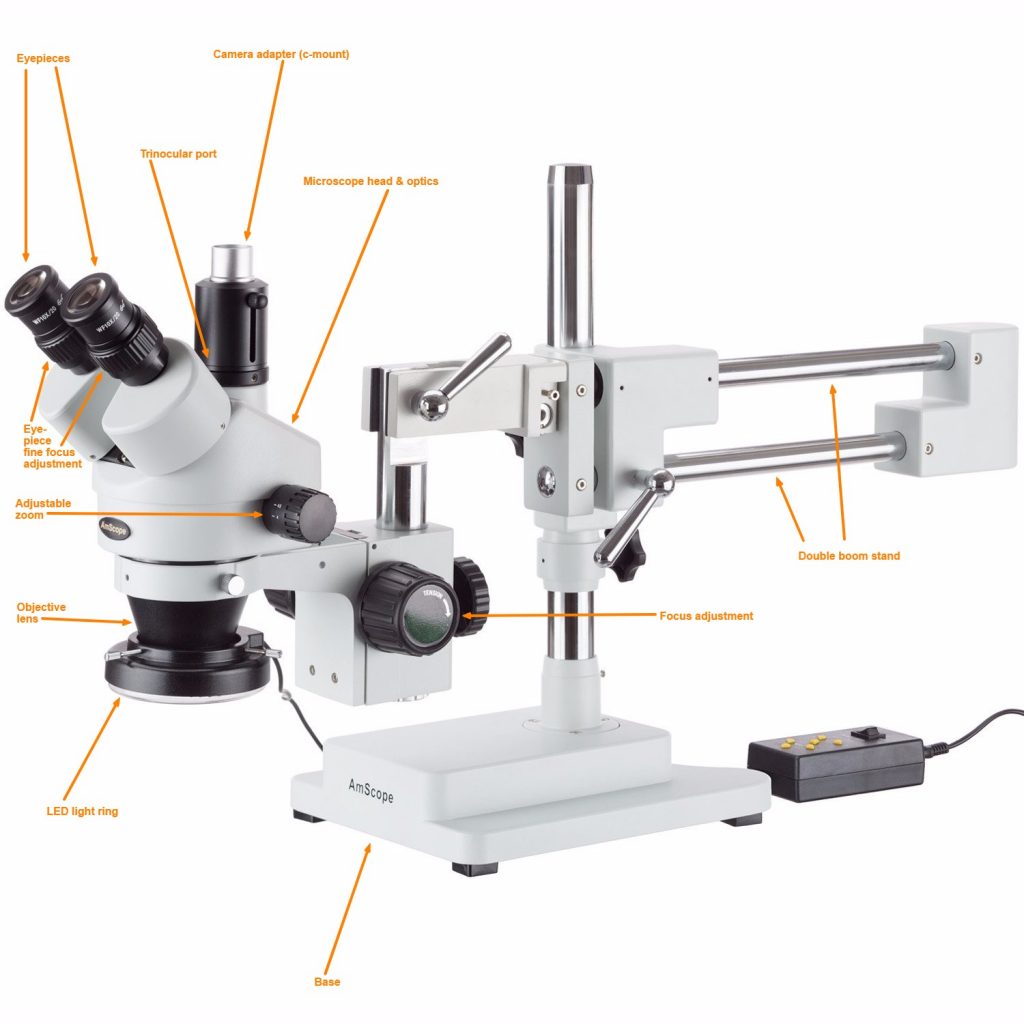
Links to everything on this folio:
- Amscope SM-4TZ-144A Professional person Trinocular Stereo Zoom Microscope ($529; amazon.com)
- Amscope EP20X30E Pair of Farthermost Widefield 20X Eyepieces (30mm) ($44; amazon.com)
- Amscope SM07 0.7X Barlow Lens For SM Stereo Microscopes (48mm) ($49; amazon.com)
- Amscope LED-144B-ZK Black 144 PCS Adjustable LED Ring Lite ($24; amazon.com)
- Amscope SM-4NTP 7X-45X Simul-Focal Stereo Lockable Zoom Microscope ($458; amazon.com)
- C-mount adapter for microscope camera ($35; amazon.com)
- 14MP 720p microscope camera with HDMI output ($139; amazon.com)
- Nikon SMZ-U microscope (Toll varies; amazon.com)
To piece of work with microscopic components, you lot will need a microscope to see. Physical test is the commencement identify to beginning with whatsoever repair job, as that will speedily tell you the technician what likely is or isn't the problem with niggling thinking on your role.
A good microscope more often than not should toll effectually $400-800 new. We highly recommend the Amscope SM-4TZ-144A ($529; amazon.com) for a first microscope. This microscope has well-nigh all the key features needed to easily run across and work with microscopic components on iPhone and other smartphone motherboards, while likewise is extremely affordable and will suit the needs of nigh repair shops for the foreseeable futurity.
The Amscope comes with a heavy double nail stand, which we prefer over articulating and single nail stands for a few reasons. Firstly, many beginners tend to opt for articulating stands because they believe that it allows them to take infinite flexibility. Withal, we have establish that most articulating stands neglect to suit our needs in a few respects – articulating stands are notoriously unstable and doubtable to vibrations from surrounding equipment like hot air stations or fifty-fifty other people walking by, making it impossible to see clearly through the microscope. In addition, articulating stands finish up beingness less flexible than blast stands because they are hard to keep in one position when working – they tend to drift upwardly and downwards and side to side so it is impossible to position the microscope exactly where nosotros want it for that item motherboard that is being worked on.
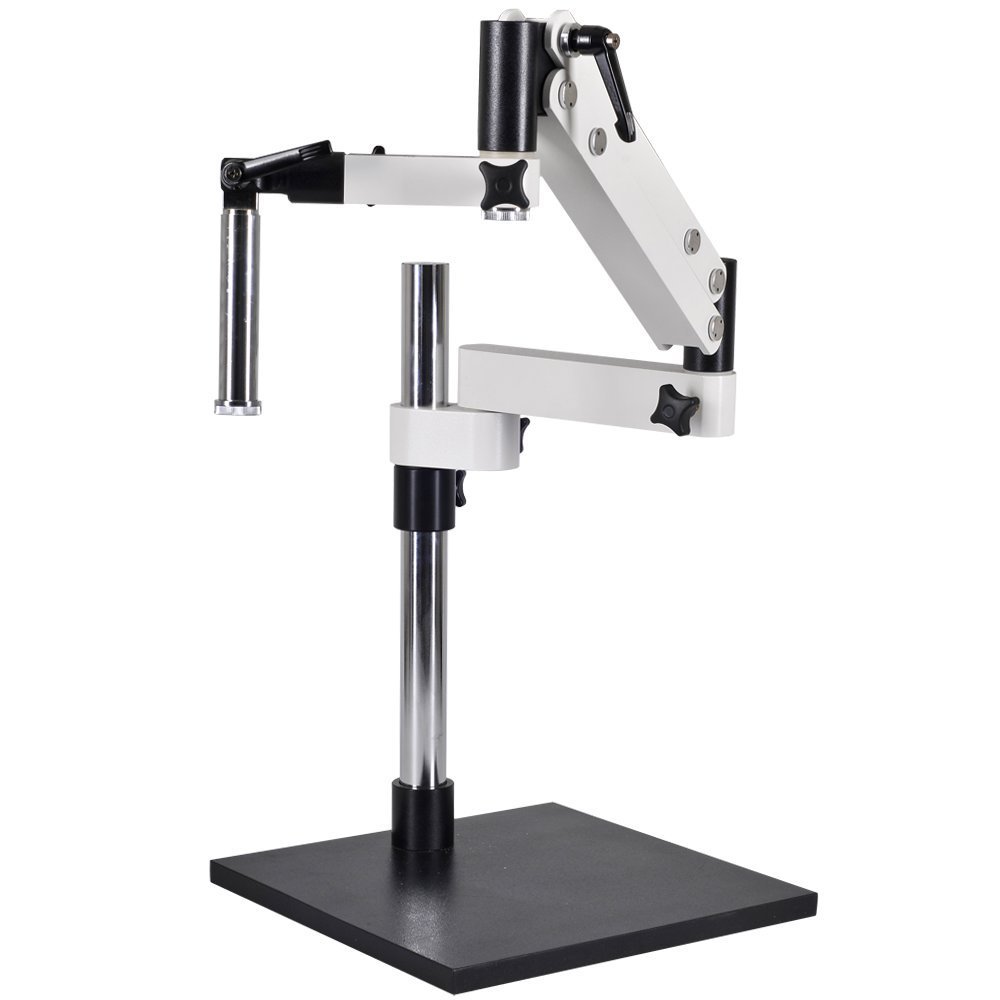
Unmarried boom stands are mostly cheaper than double boom stands, but also accept their disadvantages. Because in that location is just one cylindrical arm connecting the microscope caput to the base, if that arm does non have a locking pall then information technology is allowed to rotate effectually its axis, and besides the head of the microscope will rotate too. This becomes annoying because a lot of the time nosotros would quickly like to be able to move the head of the microscope in and out of the base to audit, but with a unmarried boom it must be locked and unlocked each time we move information technology in or out. Double nail stands allow us to leave the arm unlocked without the head rotating and so that we tin can quickly move information technology around when needed.

With the Amscope we likewise find its variable zoom feature valuable. Lower end microscopes have a fixed zoom, which only isn't applied for working with a variety of different devices. A variable zoom of around 0.5x to 4x or 5x allows u.s.a. to be able to choose our field of view and magnification for what we are working on, and be able to zoom in to inspect joints and solder assurance closely when necessary.
The eyepieces of the microscope are what more often than not provide the most magnification. A proficient quality microscope will have modular eyepieces that can exist swapped for higher or lower magnification. To summate the full magnification power of your microscope, multiply the eyepiece magnification by the objective lens magnification:
- (Eyepiece magnification power) 10 (Objective lens magnification power) = (Total maginifcation ability)
With the Amscope, information technology comes with 10x eyepieces and a 0.45x-four.5x objective lens. This gives us a total magnification ability of iv.5x-45x. The eyepieces also should come with prophylactic eyecups that some people notice helpful to rest their eyes on. Also brand sure to adapt the eyepiece width and then that you can see through both eyepieces at the same time without ane going black, and then fine tune the focus on each private eyepiece past closing i centre and turning the focus knob on the eyepiece until the motion picture is articulate.
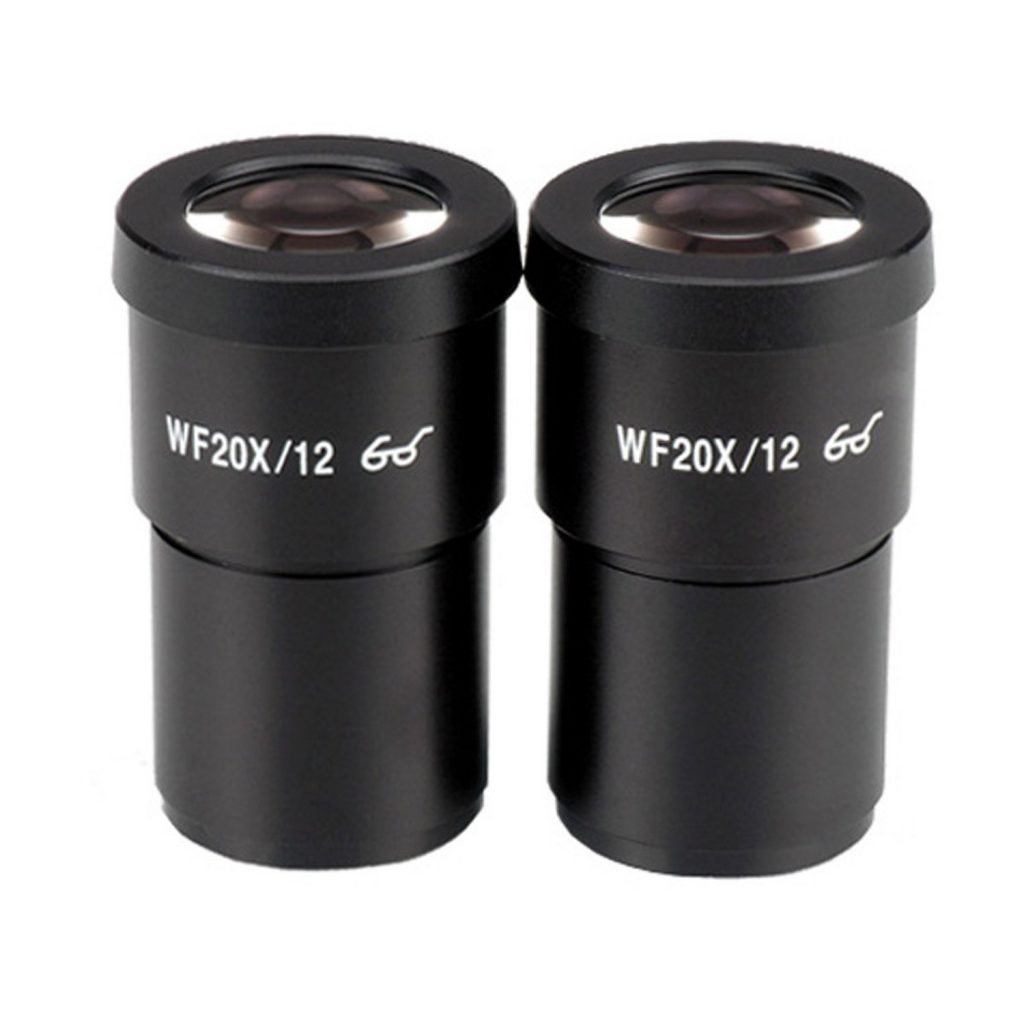
Working distance must likewise be taken into consideration when choosing a microscope, as it is extremely important to be comfy when working under the microscope for prolonged periods of time. Working distance is generally described as the distance between the workpiece and the objective lens of the microscope when the object being examined is in focus. For most microscopes including the Amscope, this is normally effectually iv" out of the box. However, nosotros find that this is way also little to exist comfortable, so we will attach a barlow lens to the head of the microscope in society to increase the working distance to vi". Some barlow lenses will even increase the working distance to eight" or more, which can exist useful for working with motherboards that have a larger height.
What is a barlow lens? A barlow lens is a lens that goes over the objective lens in of the microscope head. Typically they will screw into the head of the microscope and allow you lot to alter the field of view, working distance, and magnification.

About barlow lenses come in magnifications of 0.3x, 0.5x, 0.75x and 2x. In social club to calculate the full magnification ability of your microscope with a barlow lens, but multiply the original magnification power by the factor of the barlow lens (i.east., a microscope that originally had 45x zoom volition take 27.5x zoom later adding a 0.5x barlow lens to it):
- (Original magnification power) 10 (Barlow lens magnification) = (New magnification power)
The magnification of the barlow lens will also affect the working altitude of the microscope. Lower magnification barlow lenses volition increase the working distance, while higher magnification lenses volition decrease the working distance. In order to estimate the working distance, multiply your original working distance by the inverse of the magnification, like and so:
- (Original working distance) x (1 / barlow lens magnification) = (New working distance)
Using this formula, we can see that with a 0.5x barlow lens on our Amscope that has a working distance of iv", nosotros volition get a new working distance of 8". This is a piffling excessive for our tastes however, and we like to stick to a 0.75x barlow lens ($49; amazon.com) to get a squeamish middle footing of around vi". Keep in mind too that equally your working distance increases, the amount of light required in order to run across the workpiece too increases, so larger working distances volition require a brighter and more powerful light.

In that location are many dissimilar types of lite sources bachelor for your microscope too. The most popular ones include LED, halogen/fiber optic, and fluorescent. These also come in the class of band lights and articulating lights. We have constitute that using band lights of either the LED or halogen variety piece of work best. Ring lights attach to the bottom of your microscope head and provide ample even lighting around the workpiece. Articulating lights tend to be uneven and crave abiding adjustment.
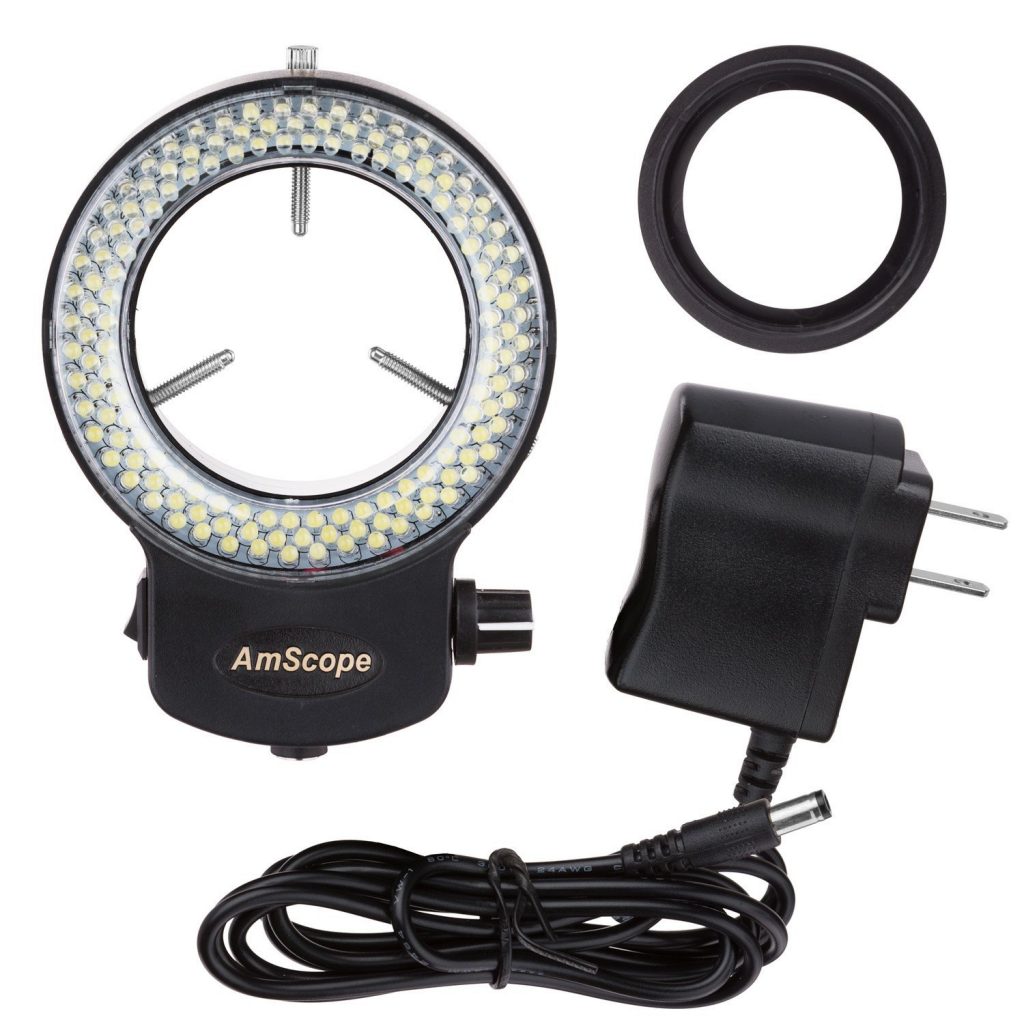
Halogen lights are by and large brighter and more powerful than commercially available LED lights, although we have seen some DIY LED lights that are equally as bright. The colour of the halogen lights also tends to have more of a yellowish tint to it every bit opposed to the brilliant blue of LED lights. This yellowish color provides better contrast when working nether the microscope and makes it easier to see especially during long periods under the microscope. However, halogen lights use a lot of electricity and therefore generate a lot of heat – call back about having to sit adjacent to a 150w space heater all twelvemonth long. They also require thick fiber optic cables to connect the band low-cal to the base station that houses the actual light bulb, limiting the microscope's range of movement.

The biggest disadvantage of halogen lights though is that the bulbs practise not last nearly every bit long equally LEDs practice and also were hard to find. We found that nosotros were bravado a bulb every three-four months, and they are not something available at Abode Depot. At $30/each and requiring united states of america to continue a few in stock in case one blew, we plant that although halogen lights made it easier and clearer when examining motherboards, the reliability, flexibility, and low operating cost of LED lights prevailed in the end.
If yous would like to add a camera to your microscope, wait for a microscope caput that is simul-focal such equally this Amscope SM-4NTP ($458; amazon.com). A photographic camera is a slap-up way to teach other technicians and assistance one another in component level logic board repair, equally well as showing customers exactly what sort of repairs need to be made to their device. The trinocular port on the microscope allows the camera to take up its own dedicated spot without losing an eyepiece, while the simul-focal prism allows the user to see through both eyepieces at once while the camera is fastened. Be careful of microscopes without simul-focal as it will disable one of the eyepieces when using the trinocular part, completely defeating the purpose of the trinocular port.
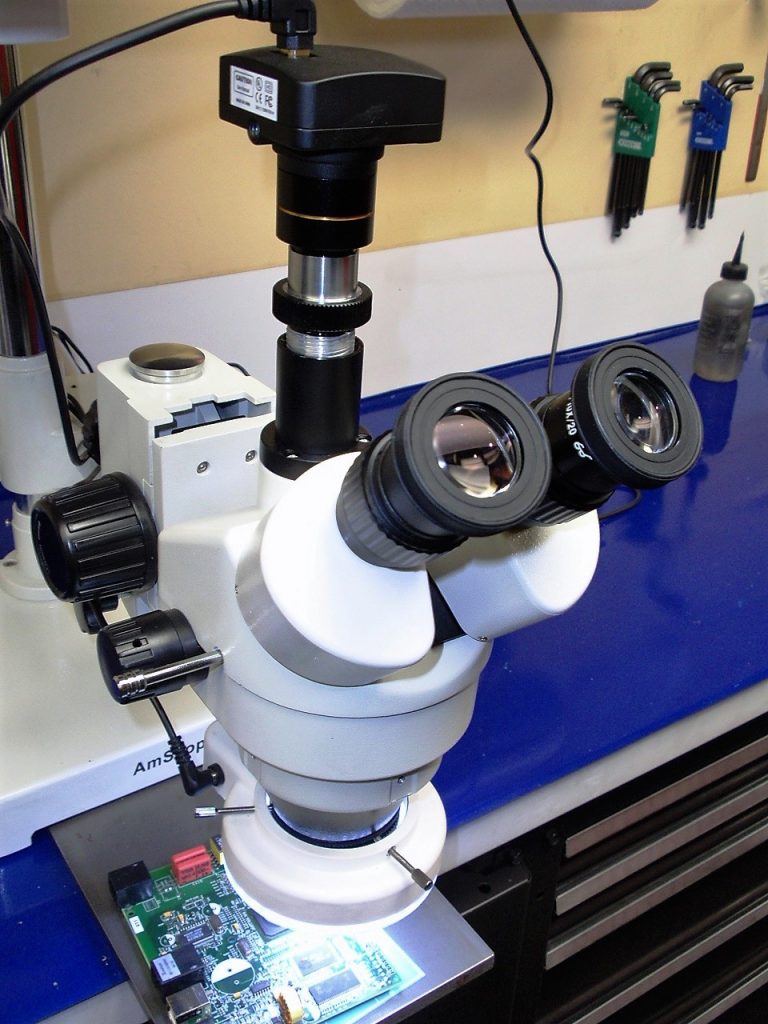
Many different cameras are available, however nosotros recommend using ones with HDMI out instead of USB out. USB out tends to be very laggy and requires special drivers and software back up, while HDMI is an industry standard and can work with TVs, monitors, capture cards, and lots more.
720p will exist acceptable, while 1080p will of course be better. In that location are too lots of options that include either 30 FPS or 60 FPS. We have found that this 720p thirty FPS camera ($139; amazon.com) provides a keen flick at a keen toll to value ratio. It likewise allows for direct HDMI output, so y'all can connect it directly to a Television receiver or monitor. Go along in heed though that most cameras will require a specific c-mount adapter to mountain it to the microscope's trinocular port. This c-mount adapter ($35; amazon.com) is the ane we found works with the Amscope SM-4NTP microscope.
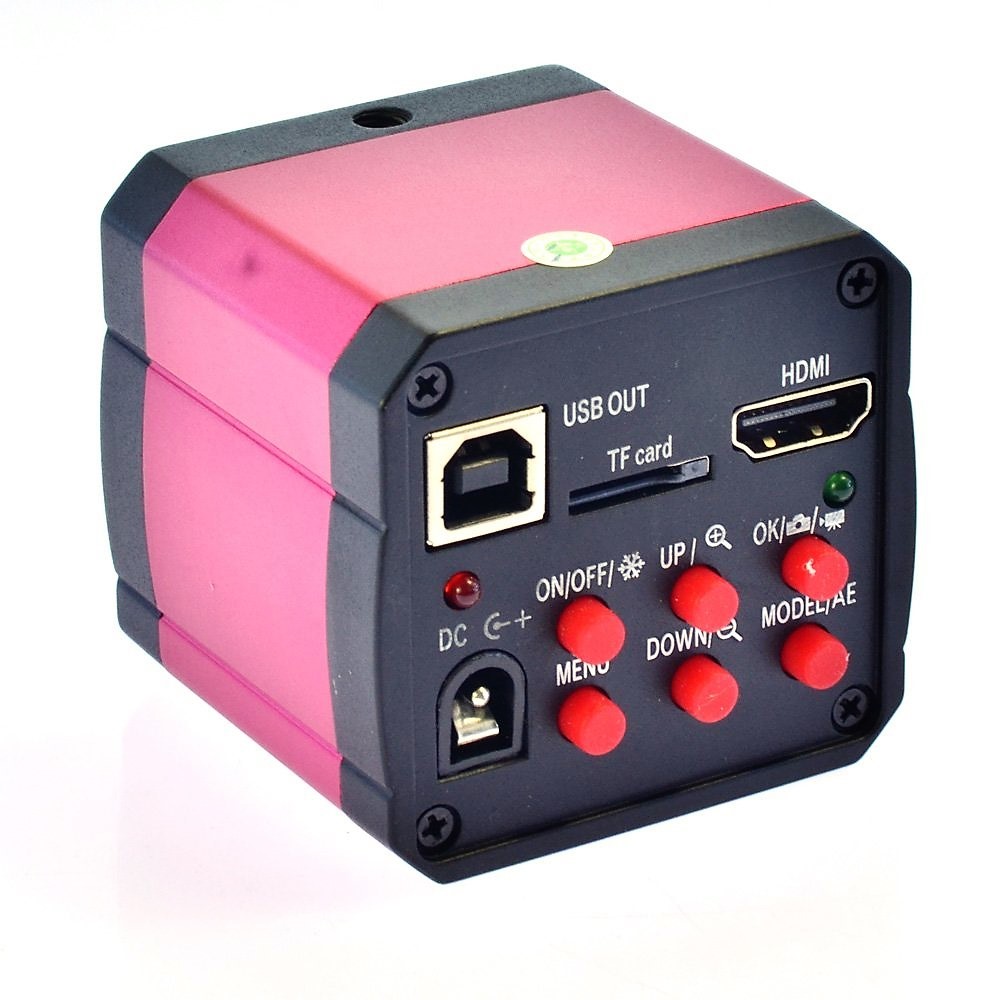
The most important part of the microscope though is the bodily glass inside the microscope. The quality of the optics varies greatly between each model and brand. For the toll, Amscope take got a completely acceptable and functional set of optics, however, for the sharpest and clearest view nosotros have constitute that Nikon lenses are unbeatable. The clarity and sharpness provide an unrivaled depth of view that is almost 3D, and nosotros found that it allowed for more than objects with different heights to appear in focus at in one case. If you lot have the time, nosotros recommend scouring eBay and surplus sites for used lab equipment which will ordinarily have significantly better optics.
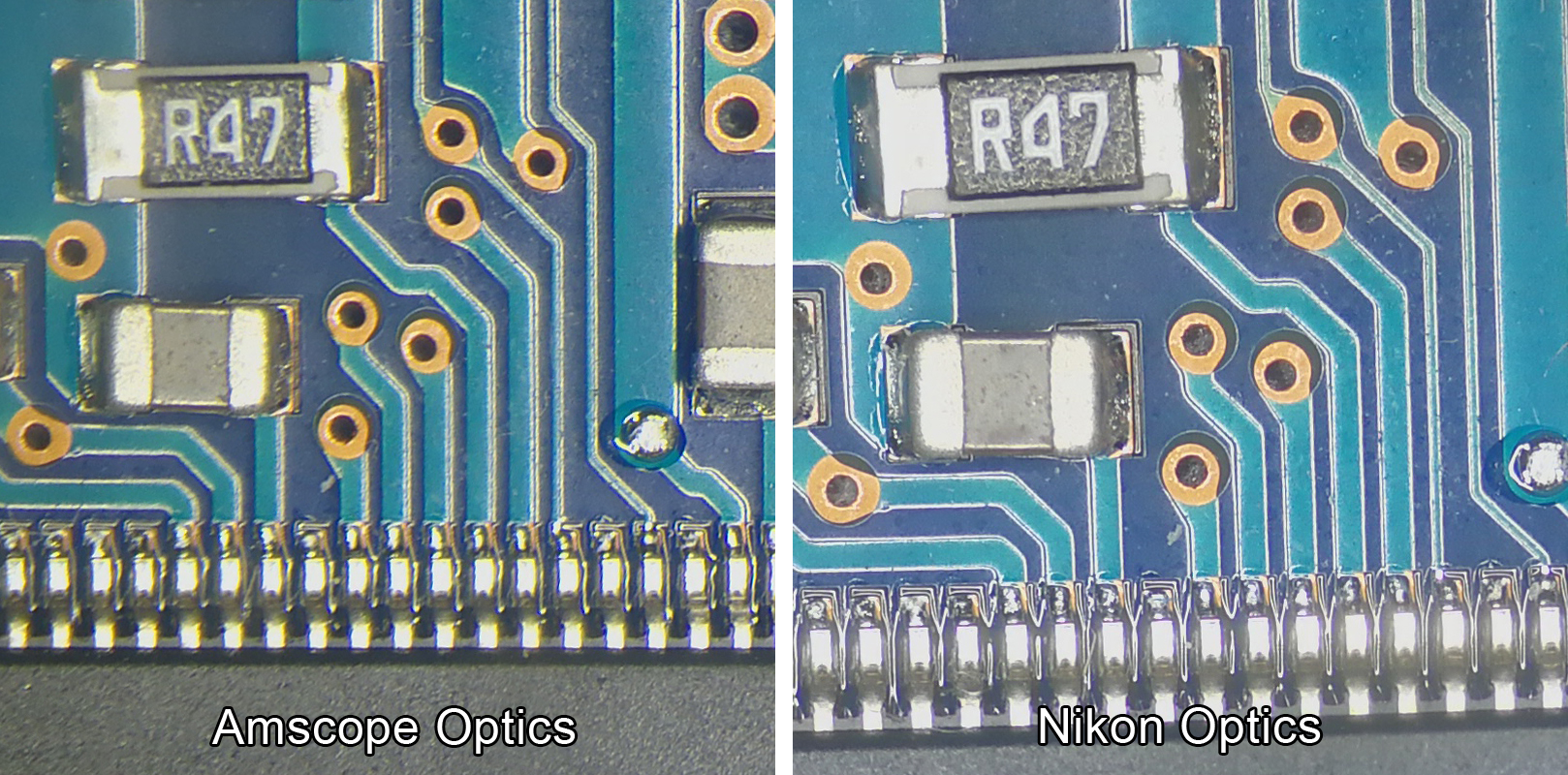
Hopefully you now understand everything you will ever need to know about microscopes for micro soldering. If you have any questions or feedback we would leave to hear from you beneath in the comments!
Micro Soldering Supply
The #ane stateside iPhone and iPad logic board parts supplier!
https://microsolderingsupply.com
Source: https://microsolderingsupply.com/blog/2017/07/17/micro-soldering-microscopes-everything-you-ever-needed-to-know/
Posted by: ballardloortambel1953.blogspot.com

0 Response to "Do I Need A Camera For Microsoldering"
Post a Comment